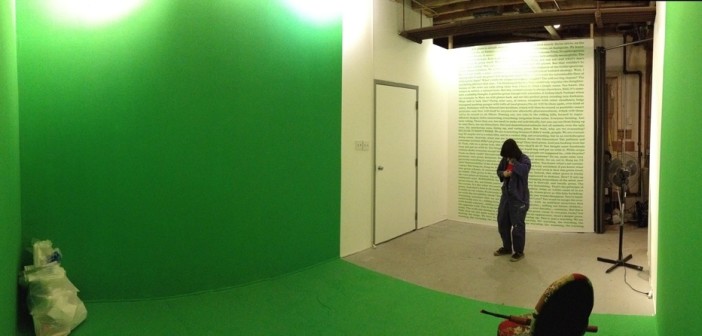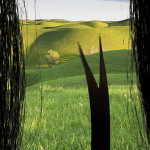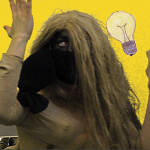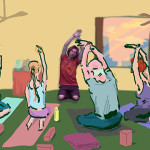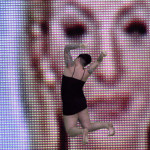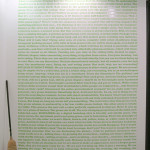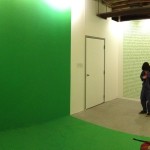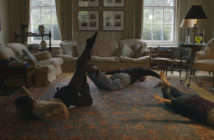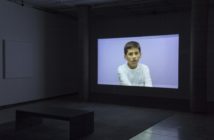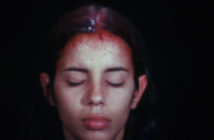All the videos were recorded in the presence of Dushko Petrovich’s Green Screed, a ceiling-to-floor text on the space’s fourth wall. By turns funny and anguished, the screed exposes the fatuousness of "green" discourse in contemporary culture and its almost comically feeble consumerist-based "solutions" to the impending ecological tsunami. Nothing is spared, from bumper sticker slogans and organic veggies to technofuturist idylls of unlimited sustainability. But what the text dwells on most are the mental feints and blinds we use to put off the day of reckoning. The densely packed lines of shiny green vinyl and rounded, nonthreatening font almost appear to abet these equivocations, inviting the eye to slide away. Thus green ultimately figures as "the very plane of fantasy" on which we project our doomed — but artisanally-crafted — dreams.
The natural versus the artificial is the axis on which the varied contributions to "Green Dream" turn. The body — in this case that of performance artist Madge of Honor — is the site of both resistance and vulnerability to the attacks of commercial beauty culture in Tara Merenda Nelson’s Beautiful Secrets, episode 2. But the battle appears to have been lost in I.B.E.’s NSA PLAY: bodies are reduced to grotesque lumps of masked flesh and prosthetic desire, bulging in their clumsy couplings out of the hidden grids imposed by social media and surveillance. Only in Corey Corcoran’s All Levels does the body find a balance between culture and nature. In gracefully rotoscoped animation, the sight of perfectly average human bodies in the act of silent breathing redeems the silly New Age rap of a hippie yoga instructor.
The contrasting of the organic and the inorganic continues in Sean Downey’s Boudu at Rest, a mock-epic saga in which the hero of Jean Renoir’s classic film is brought back in an unfortunate resurrection. Now an apathetic contemporary caveman, with a boulder for breakfast table and a totem pole in his IKEA-furnished condo, he listlessly channel surfs while trash mounts up in drifts outside. The laughter prompted by this and the other offerings in the video anthology is invariably of the uneasy sort. The forked, flapping tongue of Susan Metrican’s snake in the grass trespasses comically into a variety of pastorals in Free Range, while Stephen P. Quinlan’s Da Big Bang contrasts cosmic optics with TED Talk hot air. But in both the humor is underscored by a gulf between humans and the natural world that appears only to be widening.
Some of the best pieces are also the simplest and most direct. Bahar Yurukoglu’s Pink Ice foregrounds crisscrossings of day-glo gaffer’s tape over an Icelandic landscape to the strains of a haunting piano score. The figure of the artist garbed in the same flaming colors as the tape and appearing on both planes of the film raises the issue of the artist’s own role in either helping to bridge the nature-culture gulf or contribute to the tragic sundering. Colleen Asper foregoes special effects in Eyelet, giving us instead the stark image of a figure inscrutably cloaked in the same green as the screen room, displaying and discarding tokens of our destiny while a voice-over meditates on presence and absence, sight and blindness, ghosts. In a quite different key but likewise adding by subtraction, Ricardo De Lima’s Immaterial floats its figures in a white void, bereft of any grounding. The figures in this case are art professors engaging in crit harangues that ring as pretentious as they are ruthless now that all the props of their authority have been stripped away.
NSA PLAY, video still, I.B.E., 2014
Ultimately, however, it’s the viewer that De Lima’s film puts on the spot, posing the question of where any of us stand when either making art or appraising its place. Individually and collectively, the digital videos that comprise kijidome’s "Green Dream" come to no easy conclusions and issue no final statements. Instead, they leave the audience to continue the collaboration in their thoughts and discussions. Or then there’s always the option, as Dushko Petrovich’s wall text suggests, of turning away yet again to think of something else. Either way, the frame looks out on the abyss.
Green Dream's participating artists: Ryan Arthurs, Colleen Asper, Dan Boardman / Dylan Nelson, Stephanie Cardon / Marc McNulty, Maggie Cavallo / Ethan Berry / Tara Merenda Nelson / Madge of Honor, Corey Corcoran, Ricardo de Lima, Sean Downey, James Hull, IBE (Lenny Schnier / Alex Weick), Susan Metrican, Anthony Palocci Jr., Dushko Petrovich, Stephen Quinlan, Scott Patrick Wiener, Bahar Yurukoglu.

